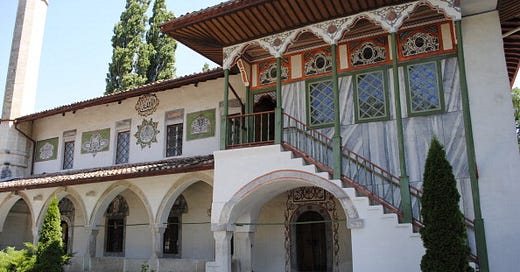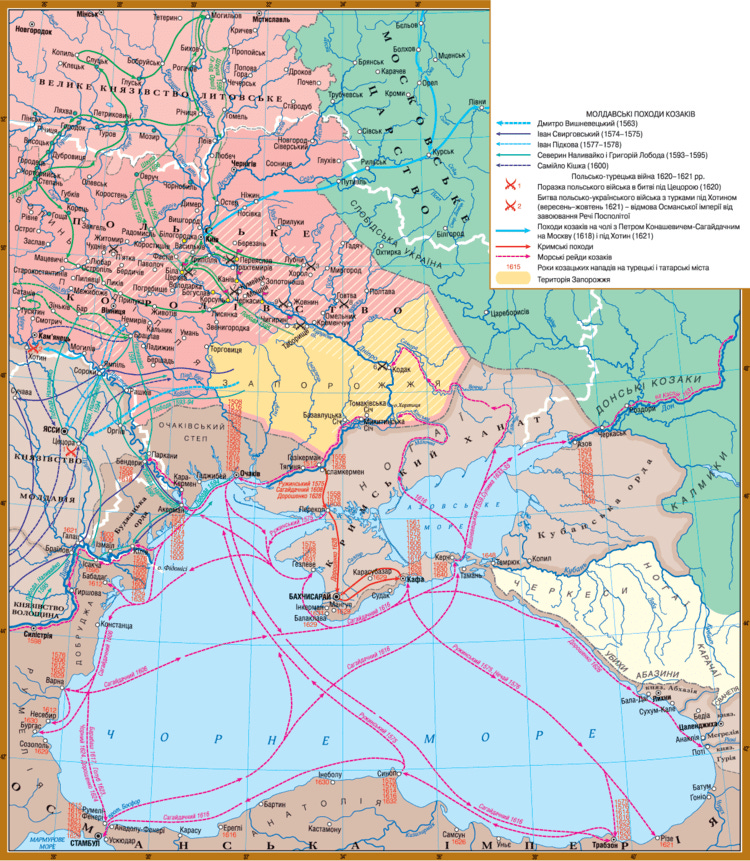For me personally, this is one of the most important lectures. In space, modern Ukraine includes lands that were well beyond the reach of ancient Rus, but well within the ambit of ancient Greek, Byzantine, Ottoman, and perhaps most importantly Crimean Tatar power. The Crimean state lasted for centuries, and is wrongly neglected. In time, we are dealing here with an important moment, the eighteenth century, in which all four alternatives to Russian power in Ukraine — Crimean Tatars, Ottomans, Poland-Lithuania, and various Ukrainian Cossack entities —fade from the picture. This had as much to do with their internal institutional failures and their dealings with one another as it did with the rise of the new Russian Empire. Petersburg would soon create a story in which those prior states did not matter, one which distorts our view of the actual history of the territory to this day. But the doings of the Ottomans, the Crimeans, the Cossacks, and the Poles/Lithuanians are very much worthy of attention on their own, and indispensable for even the most basic understanding of Ukraine
.
The video is here and the podcast version is here or here.
Reading:
Rudnyts'kyi, "Intellectual Origins of Modern Ukraine"
Plokhy, Gates of Europe, chapters 13, 14, 16, 17.
Terms:
Muscovy/Russia, Poland, Crimeans, Cossacks
Sweden, Habsburgs
Sloboda Ukraina, Left bank, right bank, Zaporizhia, Black Sea, Azov Sea
Crimea: Byzantium until 1204
Fourth Crusade, sack of Constantinople 1204
Empire of Trebizond to 1461
Genoa, colonies, 1266 to 1475
Crimean Khanate, 1441 to 1783
Taking tribute from Moscow, occasionally attacking, 1571
Kalga, deputy or serves during interregnum
Noble assembly, or kiriltai
Muslim Tatars in Lithuania
Jagiełło, Grünwald, 1410
Kitab
Ottomans
Asia Minor (Turkey)
Osman Gazi (hence "Ottoman") 1290-1326.
Mehmet II (r. 1444-1446, 1451-1481) takes Constantinople 1453
Selim I the Grim r. 1512-1520,
Battle of Mohács 1526.
Transylvania, Moldavia, Wallachia
1683, Jan Sobieski, siege of Vienna
Treaty of Karlowitz 1699
1667 Treaty of Andrusovo
1667-1668 Hetman Petro Doroshenko
1681 Peace at Bahçeseray Russia and Ottomans
Podolia, Chasidism, Israel ben Eliezer, Międzybóż
Ivan Mazepa
1689 Peter becomes tsar
Great Northern War, begins 1700
1709 Battle of Poltava, Russia reaches the Baltic
Cossacks grain export ban 1719
1722 Little Russian Collegium
1735-1739 Russo-Turkish war
1768 last Tatar slave raid into Russian territory
1768-1774 Russo-Turkish War
1785 Charter of Nobility
1789 concription of Cossacks
Kharkov University 1805
Taras Shevchenko, 1814-1861
1830-1831 Polish uprising
1840 abolition of Lithuanian statute as Polish (actually has origins in Rus)
Crimean War 1853-1856
Valuyev's Circular, 1863
Ems decree, 1876






Professor Snyder underscores how little Americans understand the evolution of modern-day Europe.
Kyiv was a major locale for Vikings in the 10th century. Subsequently what we call Ukraine was a ping pong ball in the history of Russia, the Ottomans, and, quite recently the Soviet Union, when Stalin killed 3-6 million Ukrainians by starvation in the early 1930s to finance his First Five Year Industrial Plan.
It is understandable why Ukrainians joined the Nazi army to fight against Stalin in WW II. William Taubman, in his magisterial KHRUSHCHEV, doesn’t clearly explain why Nikita impulsively ‘gave’ Crimea back to Ukraine in the mid-1950s. In 2014 Putin seized it back.
As for Poland, I recall when Margaret Thatcher visited Poland (as did the Polish-born Pope). In fact, since Poland’s grand presence in the 16th-17th century there has seldom been a Polish nation state.
It was carved and recurved until there was no Polish entity.
Under the Ribbentrop-Molotov Agreement in 1939, Stalin obtained a free hand in the Baltic States and Finland while, a few days later, Hitler invaded Poland and WW II commenced in Europe. Hitler and Stalin agreed to partition Poland. The German policy was to destroy Poland, with Poland losing 16% of its population during WW II.
Despite Churchill signing an agreement with Stalin to ‘protect’ Poland’s ‘democracy,’ the Soviets encouraged a Warsaw uprising in 1944, then withheld its troops on Warsaw’s border, while the Nazis eradicated the Polish Home Army. Meanwhile virtually all of Warsaw’s institutional buildings, including the library, the national archives, and university buildings were demolished.
That an independent Poland emerged after the break up of the Soviet empire seems miraculous.
As for the Ottomans, in 1912, two years before WW I, the Russians were salivating at the prospect of carving off portions of the fading Astro-Hungarian empire and obtaining a warm water port in Crimea.
Another modern-day miracle was the gradual evolution of Ukrainian sovereign independence, after a tentative start in 2010. A former TV comic, President Zelensky was an unlikely person to become a heroic personality after Putin’s brutal invasion of Ukraine. Even a number of Russian-speaking Ukrainians have become courageous nationalists proudly fighting for their homeland.
Professor Snyder provides Americans a remarkable insight into the complexities of what we see as modern-day Europe. Currently the Biden-sparked Western (and East European) riposte to Putin’s megalomanic effort to expand ‘Greater Russia’ is simply the latest chapter in Europe’s checkerboard evolution.
I hope that Washington, including ‘Republicans,’ are becoming Snyderized. What’s at stake is the sanctity of current-day Europe. The failure to stop Putin would have massive implications for Eastern Europe and also indicate to China that the ‘West’ would be disunited, in the event of a takeover initiative in Taiwan.
Thanks for that map! I've taught myself the Cyrillic alphabet, so that I can now read place names and names of people.